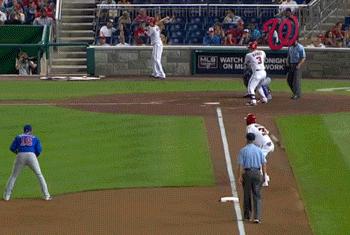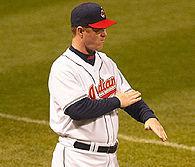Tips for giving the squeeze sign.
Be careful not to develop a "tell"
when giving signs to players.
Be careful of body language. Good sign stealers don't just look at what signs are given by the third base coach. They also look for patterns in body language of the coach giving the signs. For example, a coach might develop the habit of standing still while giving signs when nothing is on. However, when a play is on (steal, bunt, squeeze, etc), he may unknowingly take a couple steps towards the batter or runner before giving the sign as if to say "I want to make sure he sees this sign." Without realizing it, he just tipped off that something may be on. In card playing, this is called a "tell." A player unintentionally develops a habit - an eye or hand movement, etc. - that tips off when they are bluffing or have a good hand. Coaches sometimes do the same thing. This type of thing can also occur in situations when the third base coach receives the signs from the manager in the dugout who then passes them on to the batter. The third base coach may act very relaxed when the manager flashes a set of signs when nothing is on but all of a sudden stiffen up or focus on the manager a bit more when he sees the squeeze sign coming from the dugout. There are many variations of this. The point is to do your best not to develop any unusual habits during the process of giving the sign to the batter.
Tips for receiving the sign
Be careful of body language. What you just read about coaches tipping off the squeeze sign applies to batters as well. A batter should never alter his routine during and/or after they get the squeeze sign. Any variation to their normal pre at-bat routine signals that something different might be about to happen. Some common mistakes hitters make are:
- Being visibly surprised when they receive the squeeze sign. With less than two outs and a runner on third, a hitter should NEVER be surprised when the squeeze is signaled for.
- Giving an obvious "I got the sign" message or return sign to the coach and runner at third. Continue reading for further details on this.
- Positioning their feet in the front of the batter's box when they normally stand in the back of the box - a tell tale sign that a bunt is coming.
- Positioning their hands closer to their chest instead of off the back shoulder in the normal hitting position - also a tell tale sign of a bunt.
The return sign. On many teams, it is a common procedure to let the third base coach and runner know that you (the hitter) have received the sign for the squeeze play. After getting the sign, the hitter is required to give some kind of signal back to the coach and runner. It could be touching the bill of his helmet, taking a practice swing, stepping into the box with his right foot first, or anything else that the team decides. The reason for this is that nobody wants to be sprinting down the line towards home only to have the hitter swing away and possibly hit a ball down the third base line. You can imagine the danger in that. The clip below provides an example.

This scare probably took at least 3 years off the runner's life.
If the hitter does not respond with the return sign, the coach can call timeout before the pitch to avoid this danger. If a coach does require a return sign, care should be taken to choose something that batters commonly do so that the other teams' spies don't notice it.It is important to note that any return signal given by the hitter increases the likelihood that the defense will be tipped off on the squeeze. Because of this, some teams do not require a return sign. In that case, it just becomes the very important responsibility of the batter to NOT miss the squeeze sign. Each coach should weigh the pros and cons and develop a policy they are comfortable with.
Part 1: The why's and when's of the suicide squeeze.
Part 2: Giving and receiving the squeeze sign.
Part 3: Timing for the batter and the runner.
Part 4: The mechanics of the bunt.
Part 5: The bench.


